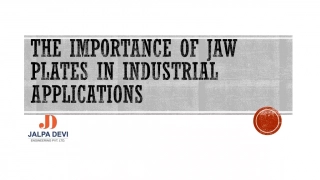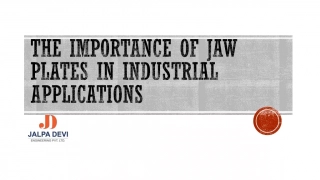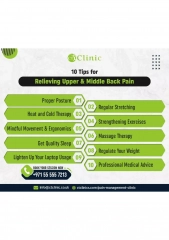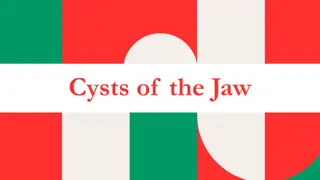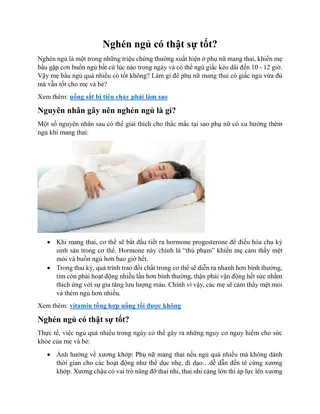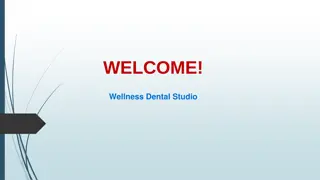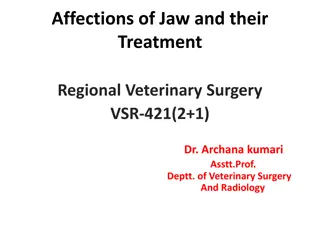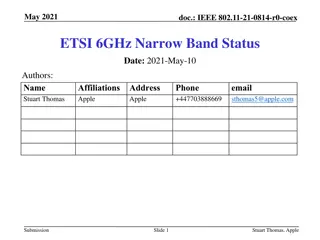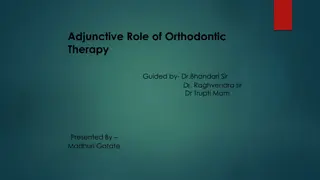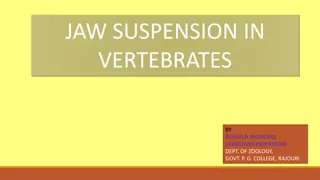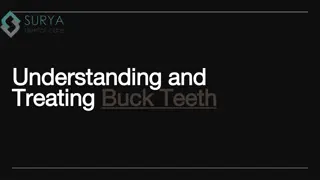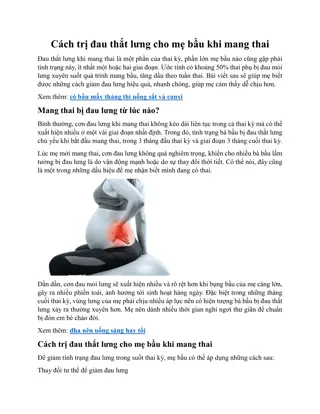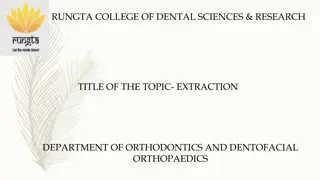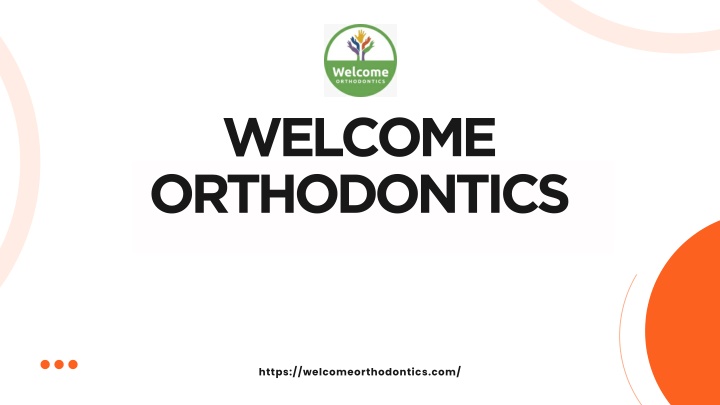
Early Orthodontic Signs of a Narrow Upper Jaw (That Parents Often Miss)
A childu2019s facial structure, breathing patterns, and dental development are closely linked to the size and shape of their upper jaw. A narrow upper jaw can quietly trigger a range of issuesu2014from crowded teeth and misaligned bites to mouth br
Download Presentation

Please find below an Image/Link to download the presentation.
The content on the website is provided AS IS for your information and personal use only. It may not be sold, licensed, or shared on other websites without obtaining consent from the author. If you encounter any issues during the download, it is possible that the publisher has removed the file from their server.
You are allowed to download the files provided on this website for personal or commercial use, subject to the condition that they are used lawfully. All files are the property of their respective owners.
The content on the website is provided AS IS for your information and personal use only. It may not be sold, licensed, or shared on other websites without obtaining consent from the author.
E N D
Presentation Transcript
WELCOME ORTHODONTICS https://welcomeorthodontics.com/
Early Orthodontic Signs of a Narrow Upper Jaw (That Parents Often Miss)
Early Orthodontic Signs of a Narrow Upper Jaw (That Parents Often Miss) A child s facial structure, breathing patterns, and dental development are closely linked to the size and shape of their upper jaw. A narrow upper jaw can quietly trigger a range of issues from crowded teeth and misaligned bites to mouth breathing and speech problems. The challenge? These signs often appear subtle in the early stages and are easy to overlook. Understanding the early orthodontic indicators of maxillary constriction is essential for timely intervention. With proper evaluation and treatment such as teeth braces in California or palatal expanders many complications can be prevented before they fully develop. This article explores how to recognize these signs early and what treatment options are available to support healthy jaw growth in children.
What Is a Narrow Upper Jaw? The upper jaw, also known as the maxilla, plays a vital role in facial symmetry, airway function, and how the upper and lower teeth fit together. A narrow maxilla means the arch of the upper teeth is too small in width, which can cause a number of structural and functional problems. When the upper jaw is too narrow, it may: Cause the upper teeth to bite inside the lower teeth (posterior crossbite) Restrict space for permanent teeth to erupt, leading to crowding Lead to breathing issues due to a constricted nasal passage Affect facial development and jaw alignment It s important to note that the upper jaw s growth is more flexible during early childhood, making it an ideal time for orthodontic guidance.
Subtle Signs of a Narrow Upper Jaw That Parents Often Miss Let s dive into the most common but easily overlooked signs that may indicate your child has a narrow upper jaw. 1. Mouth Breathing, Especially at Night Children with narrow palates often struggle to breathe through their noses, especially when asleep. If your child sleeps with their mouth open, snores, or appears restless at night, it may not just be a bad sleep habit it could be linked to insufficient airway space caused by jaw constriction. 2. Crowded or Crooked Baby Teeth Many parents believe that baby teeth don t matter as much since they fall out anyway. However, crooked teeth during the early years can signal a lack of space in the jaw for adult teeth to come in properly. It s often an early warning sign of a narrow maxilla.
3. Delayed Loss of Baby Teeth Sometimes, the delay in losing baby teeth is due to limited space in the jaw. When there isn t enough room, permanent teeth can t erupt normally, resulting in impaction or misalignment. 4. Crossbite or Midline Misalignment If you notice that your child s upper teeth sit inside the lower ones, or if their bite seems off-center when they close their mouth, these may be signs of crossbite or a shifting jaw both linked to a narrow upper arch. 5. Speech Difficulties Certain speech issues, especially problems articulating s or sh sounds, may stem from abnormal tongue posture or restricted oral cavity space due to a high and narrow palate.
The Role of Early Orthodontic Evaluation The American Association of Orthodontists recommends that children get their first orthodontic evaluation by age 7. This timing allows orthodontists to detect and intercept growth issues like a narrow upper jaw before permanent teeth are fully in place. Early assessment helps determine if interventions such as: Palatal expanders Partial braces Myofunctional therapy are needed to guide the development of the upper arch and prevent more invasive procedures later. If you re in search of orthodontics braces in California or early treatment options, many practices like Welcome Orthodontics offer complimentary consultations to assess your child s unique case.
Why a Narrow Upper Jaw Should Be Treated Early 1. Avoiding Future Orthodontic Complications Addressing jaw width issues early can reduce or eliminate the need for extractions, headgear, or even jaw surgery later on. In fact, expansion during growth years is often much simpler and more comfortable than in the teenage or adult years. 2. Improved Facial Development The width of the upper jaw affects not only dental alignment but also midface development. Expanding a narrow upper arch can help create a more harmonious, balanced facial appearance.
Orthodontic Solutions for a Narrow Upper Jaw Once diagnosed, there are several proven orthodontic treatments to address a narrow maxilla. These include: 1. Palatal Expanders Palatal expanders are most effective between ages 7 and 12, while the mid-palatal suture is still developing. These devices apply gentle pressure to the upper molars, gradually widening the jaw and creating space for teeth to erupt naturally. 2. Early Braces In some cases, partial braces are placed to help align teeth and hold the expansion. These teeth braces in California are custom-tailored for younger children to be comfortable and minimally invasive. 3. Invisalign First In certain mild cases, clear aligners like Invisalign First may be used for interceptive treatment. They can help straighten teeth without braces, offering a convenient and visually discreet solution.
Teens and Adults with Narrow Upper Jaws While early intervention is best, teens and adults with narrow upper jaws still have treatment options. Invisalign, for example, can help guide teeth into better alignment and manage bite issues even in fully developed jaws. While the expansion may be more limited, clear aligners and braces are still highly effective in correcting crowded or crooked teeth. Patients often ask if expansion means they ll need braces without extraction of permanent teeth. In many cases, expansion creates enough space to avoid extractions altogether one of the many benefits of acting early. Moreover, adults looking for teeth braces for adults in California can explore more subtle options like ceramic braces or braces behind the teeth in Oakland (lingual braces), depending on their needs.
The Cost of Waiting Many parents delay orthodontic treatment, assuming it s best to wait until all permanent teeth erupt. Unfortunately, this often results in more complex treatment needs and higher costs. Early care is not only more efficient it s often more affordable and quality orthodontics compared to fixing severe issues down the road.
Conclusion A narrow upper jaw is more than just a dental issue it affects facial balance, speech, breathing, and long-term oral health. The challenge is that many early signs go unnoticed by parents until more complex issues develop. From mouth breathing and speech delays to crooked teeth and crossbites, your child may already be showing signs that it s time to see an orthodontist.

